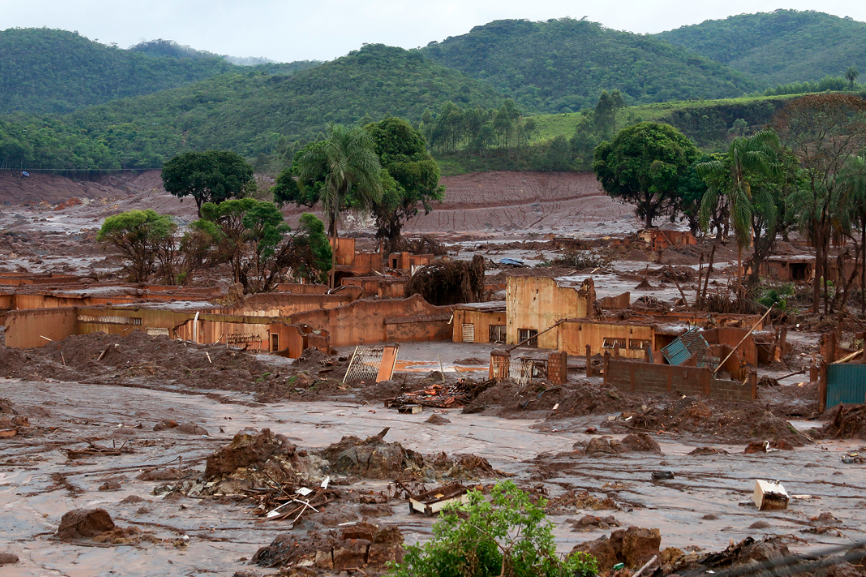13 February, 2019No one ever hears about tailings dams until they go wrong. But when they fail, the results can be catastrophic. So, as their numbers increase, what exactly are tailings dams and why should we be worried?
What are mine tailings?
Tailings are the waste products from mining. Mechanical and chemical processes are used to grind up rock into a fine sand to extract the valuable mineral or metal from the rock ore. All the unrecoverable and uneconomic remnants from this process are waste. They include finely ground rock particles, chemicals, minerals and water. Depending on the type of mining, tailings can be liquid, solid or a slurry of fine particles. Many substances found in tailings are toxic, even radioactive, and it’s not uncommon to find large amounts of cyanide, mercury and arsenic in tailings.
What are tailings dams?
Tailings dams are used to store water and waste that come as by products from the mining process. It is estimated there are at least 3,500 tailings dams around the world. But as there are around 30,000 industrial mines, the number of tailings dams is likely to be much higher.
Tailings dams can be huge in size, as big as lakes, and reach 300 metres high. As the slurry of waste is piped into the dam, the solids settle to the bottom and the water is recycled to be used in the separation process again.
Rather than reinforced concrete, tailings dams use earth or rock to create a barrage. However, most tailings dams use the cheaper but more dangerous upstream method of construction, using the tailings themselves to create a barrier. The dam is then continually raised to accommodate more waste. These dams are more unstable and more prone to leakage.
Tailings dams need regular maintenance and monitoring to ensure that there is sufficient drainage and the dam is strong enough to contain the mining waste.
Tailings dams can pose a threat to local wildlife as birds and animals bathe in and drink from the contaminated waters. Leakage of toxic substances from tailings dams can also cause damage to the immediate environment.
What are the consequences of collapse?
In the past ten years, there have been 31 recorded major tailings dam failures between 2008 and 2018, not including the devastating failure of mining company Vale’s dam in Brumadinho, Brazil on 25 January 2019, in which 300 people are presumed dead.
In Canada, the Mount Polley copper-gold mine dam collapse in 2014 released 25 million cubic metres of wastewater and tailings into adjacent water systems and lakes. That’s enough to fill 20,000 Olympic swimming pools.
A year earlier, the mine’s owner, Imperial Metals, reported that the tailings dam contained 84,831 kilograms of arsenic, 38,218 kilograms of lead and 562 kilograms of mercury along with other minerals and waste products.
In 2015, the Samarco dam collapse in Brazil released 33 million cubic metres of iron ore tailings slurry into the environment, killing 19 people, displacing 600 families and contaminating waterways for 620km downriver until it reached the ocean. It is feared that precious ecosystems and fish life that support indigenous communities will never recover.
There are also grave concerns for the safety of legacy tailing dams that are no longer used but still pose a considerable threat to life and the environment if they fail.
Are tailings dams necessary?
Traditional storage facilities, such as the ones involved in the Brumadinho and Samarco tragedies, are used by the mining industry simply because they are cheap. New technologies are available that substantially reduce or mitigate the risk associated with potential dam failures, such as the filtered tailings process, which reduces the amount water to minimize volume and improve stability. Dry tailings disposal is another alternative that offers significant benefits in terms of environmental sustainability, as well as worker and community safety.
What can be done to improve tailings dam safety?
Tailings dam failures are not inevitable and can be prevented. Mining companies must listen to workers and unions, who are frequently the first to flag safety issues but too often ignored. IndustriALL Global Union has worked with the multisector Initiative for Responsible Mining Assurance (IRMA) to set the highest standards of tailings dam safety along with the International Council on Mining & Metals which has produced guidelines on preventing catastrophic failure of tailings storage facilities. The mining industry must urgently adhere to these standards to prevent future disasters.
